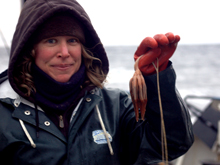
Sarah Mincks Hardy holds an octocoral as tall as she is, found in a trawl on September 22. The live, intact specimen helped other scientists aboard identify the pieces of octocoral skeletons they had found in deeper waters in the preceding days. Click image for larger view and image credit.
Awaiting the Beam Trawl’s Surprises
September 24, 2009
Sarah Mincks Hardy
Assistant Professor
University of Alaska – Fairbanks
“Nyet fish!” says Nikolai, as we sift through our living treasures, freshly brought up from the muddy depths. Actually, there are quite a few small fish mixed in with our haul, but their numbers are overwhelmed by the mound of other critters we have retrieved. Nikolai is one of the Russian sailors who seems to particularly enjoy looking for treasures in the trawls, and has become a sort of honorary biologist in recent days. We have just brought aboard the beam trawl which was dragged along the seafloor for only a few minutes, and a crowd of curious onlookers — scientist and sailors alike — has gathered to see what’s come up.
It normally takes a group of six to eight people to pull the heavy net aboard, but if we have been particularly successful we may need some help from the winch. Once a little (or a lot of) mud is rinsed from the net, the rope that cinches the “cod end” of the net closed at the bottom is loosened to allow the contents to spill out. We spread the catch out on a table and everyone gets to have a look. On a pleasant sunny day the crowd is particularly big, and there are lots of hands to help pick through the catch; in the middle of the night or in a strong wind the crowd is smaller.
One particularly creepy-crawly has come up today, which has brought many out on deck: the giant isopod Saduria that is commonly found here in the East Siberian Sea. With some as big as the palm of my hand, these marine insects show a strong family resemblance to their distant cousin, the cockroach, as they writhe around on the table, legs flailing — not for the squeamish.
Scary monsters aside, we get to work removing the fish from our catch, which are then whisked away by the fish researchers for a closer look. Then the rest of our team takes over to examine the invertebrate epibenthos, organisms that live on the seafloor. (Epibenthos literally means “upon the bottom.") Some are interested in certain groups like snails and clams; others focus on amphipods, small shrimp-like animals that are an important food source for whales.
I, however, am much less choosy. Working with graduate student Jared Weems, my task is to record all the organisms we collect, and in what numbers. Luckily, the other members of the epibenthos team do their best to help us name all the members of our catch. Besides the isopods, snails, clams, and amphipods, we’ve found snow crabs, hermit crabs, lyre crabs, sea stars, brittle stars, basket stars, anemones, octocorals, snails, sponges, sea cucumbers, tubeworms, and other worms. The Russian biologists we are fortunate to work with on the RUSALCA program are some of the world’s experts on these Arctic species — and better yet, they can actually read all the best books on the topic, which are only published in Russian!
Once our catch is sorted, Jared and I move in from the cold to do our counting and weighing. The weighing is particularly challenging at sea, since the movement of the ship makes most modern scales useless. We use a very low-tech spring scale which most fishermen have likely seen. Each type of organism is then counted into a bag and dangled from the scale. If we don’t know the identity of one critter, we will save an example to take back to our lab. Otherwise we try to put back as much of the catch as possible.
Even though counting heads seems like a simple task, there is surprisingly little information from this region. As the Arctic environment continues to undergo changes, such as loss of sea ice and warming of seawater temperatures, we want to be able to keep an eye on these organisms to see if and how they are being affected. But we can’t do that if we don’t know where they are now. So we need to get a better idea of who is "at home" here, and in what numbers.
One of the main goals of RUSALCA is to return to these same locations in multiple years and monitor any changes. Our group will be checking back to see if population sizes have decreased or increased, or if other changes have occurred in the community. (For example, will we see "anyone" new in the area we have never seen before?) Because there are so many different types of measurements being made on this environment at the same time, we hope we will be able to identify the reasons for any changes we do see.















